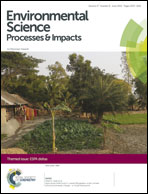Research highlights: natural passive samplers – plants as biomonitors
Abstract
In the past decade, interest in boosting the collection of data on environmental pollutants while reducing costs has spurred intensive research into passive samplers, instruments that monitor the environment through the free flow of chemical species. These devices, although relatively inexpensive compared to active sampling technologies, are often tailored for collection of specific contaminants or monitoring of a single phase, typically water or air. Plants as versatile, natural passive samplers have gained increased attention in recent years due to their ability to absorb a diverse range of chemicals from the air, water, and soil. Trees, lichens, and other flora have evolved exquisite biological features to facilitate uptake of nutrients and water from the ground and conduct gas exchange on an extraordinary scale, making them excellent monitors of their surroundings. Sampling established plant specimens in a region also provides both historical and spatial data on environmental contaminants at relatively low cost in a non-invasive manner. This Highlight presents several recent publications that demonstrate how plant biomonitoring can be used to map the distribution of a variety of pollutants and identify their sources.


 Please wait while we load your content...
Please wait while we load your content...